
Nakuru is a city in the Rift Valley region of Kenya. It is the capital of Nakuru County, and is the third largest urban area in Kenya. As of 2019, Nakuru has an urban population of 570,674, making it the largest urban centre in the Rift Valley, succeeding Eldoret, Uasin Gishu County. The city lies along the Nairobi–Nakuru Highway, 160 kilometres (99 mi) from Nairobi.

Nakuru County is a county in Kenya. It is county number 32 out of the 47 Kenyan counties. Nakuru County is a host to Kenya's Fourth City – Nakuru City. On 1 December 2021, President Uhuru Kenyatta awarded a City Charter status to Nakuru, ranking it with Nairobi, Mombasa, and Kisumu as the cities in Kenya. With a population of 2,162,202, it is the third most populous county in Kenya after Nairobi County and Kiambu County, in that order. With an area of 7,496.5 km2, it is Kenya's 19th largest county in size. Until 21 August 2010, it formed part of Rift Valley Province.

Lake Nakuru is one of the Rift Valley lakes, located at an elevation of 1,754 m (5,755 ft) above sea level. It lies to the south of Nakuru, in the rift valley of Kenya and is protected by Lake Nakuru National Park.
Thomas Patrick Gilbert Cholmondeley was a Kenyan farmer. He was the great-grandson of the 3rd Baron Delamere, one of the first and most influential British settlers in Kenya, and was heir to the Delamere title at the time of his death, being the eldest son of the 5th Baron Delamere.

Gilgil, Kenya, is a town in Nakuru County, Kenya. The town is located between Naivasha and Nakuru and along the Nairobi - Nakuru highway. It is to the west of the Gilgil River, which flows south to feed Lake Naivasha.

The Happy Valley set was a group of mostly British and Anglo-Irish aristocrats and adventurers who settled in the "Happy Valley" region of the Wanjohi Valley, near the Aberdare mountain range, in colonial Kenya between the 1920s and the 1940s. During the 1930s, the group became infamous for its hedonistic, decadent lifestyles and exploits amid reports of drug use and sexual promiscuity.
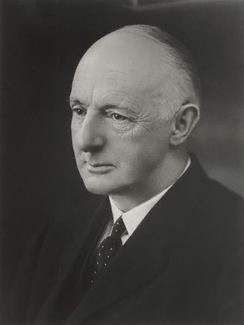
Hugh Cholmondeley, 3rd Baron Delamere,, styled The Honourable from birth until 1887, was a British peer. He was one of the first and most influential British settlers in Kenya.

Lake Elmenteita is a soda lake, in the Great Rift Valley, about 120 km northwest of Nairobi, Kenya.
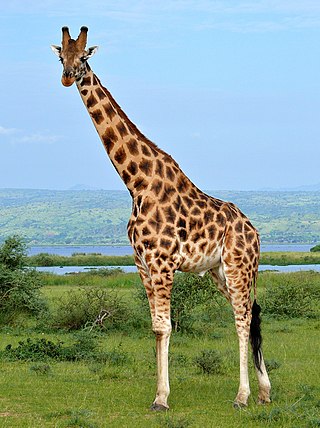
Rothschild's giraffe is an ecotype of the Nubian giraffe. It is one of the most endangered distinct populations of giraffe, with 1,399 mature individuals estimated in the wild in 2018.
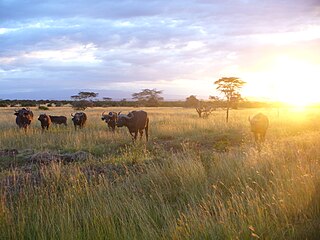
The wildlife of Kenya refers to its fauna. The diversity of Kenya's wildlife has garnered international fame, especially for its populations of large mammals. Mammal species include lion, cheetah hippopotamus, African buffalo, wildebeest (Connochaetes), African bush elephant, zebra (Equus), giraffe (Giraffa), and rhinoceros. Kenya has a very diverse population of birds, including flamingo and common ostrich.
Galbraith Lowry Egerton Cole (1881–1929) was an Anglo-Irish pioneer settler and farmer (1905) of the East Africa Protectorate. Part of his Kekopey Ranch on Lake Elementaita, Kenya, where he is buried, is preserved today as the Lake Elementaita Lodge.

The Elementeita Badlands, also known as the Otutu Forest or Ututu Forest, is a lava flow in Kenya that covers approximately 36 square kilometres. The area was previously covered in thick dryland forest characterized by cedar trees,, and Leleshwa bushes. In addition, Wild Jasmine and Boophone are also found.
Mawe Mbili is a volcanic rock formation on the northern edge of the Elmenteita Badlands and within the Soysambu Conservancy, in Nakuru County of Rift Valley Province, southern Kenya. The rock formation is located at the base of Scout Hat Hill, about 5 kilometres (3.1 mi) south of Lake Elmenteita and northwest of Nairobi.
Hugh George Cholmondeley, 5th Baron Delamere, styled The Honourable Hugh George Cholmondeley from birth until 1979, is a British peer. He is a well-known figure in the evolution and development of post-colonial Kenya. He owns the vast Soysambu Ranch in Kenya.

Giraffe Manor is a small hotel in the Lang'ata suburb of Nairobi, Kenya which, together with its associated Giraffe Centre, serves as a home to a number of endangered Rothschild's giraffes, and operates a breeding programme to reintroduce breeding pairs back into the wild to secure the future of the subspecies.

Tanzania contains some 20 percent of the species of Africa's large mammal population, found across its reserves, conservation areas, marine parks, and 17 national parks, spread over an area of more than 42,000 square kilometres (16,000 sq mi) and forming approximately 38 percent of the country's territory. Wildlife resources of Tanzania are described as "without parallel in Africa" and "the prime game viewing country". Serengeti National Park, the country's second largest national park area at 14,763 square kilometres (5,700 sq mi), is located in northern Tanzania and is famous for its extensive migratory herds of wildebeests and zebra while also having the reputation as one of the great natural wonders of the world. The Ngorongoro Conservation Area, established in 1959, is a UNESCO World Heritage Site and inhabited by the Maasai people. Its Ngorongoro Crater is the largest intact caldera in the world.
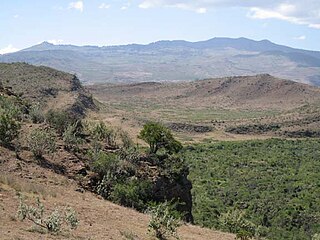
Ol Doinyo Eburru is an active complex of volcanoes in the Great Rift Valley, Kenya to the northwest of Lake Naivasha. It is being exploited for geothermal energy. Soysambu Conservancy is located to the north of the massif, between Lake Elmenteita to the east and Lake Nakuru to the west.
The Shompole Conservancy is a large privately operated conservation area in the south of the Great Rift Valley, Kenya. It is located between Lake Magadi to the north and Lake Natron to the south, two alkaline lakes.
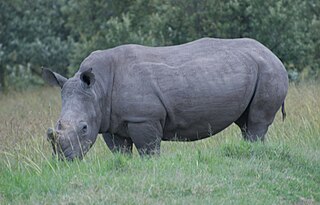
The Kigio Wildlife Conservancy is a protected Conservancy near Gilgil in the Great Rift Valley of Kenya. It is owned and operated by the local community.
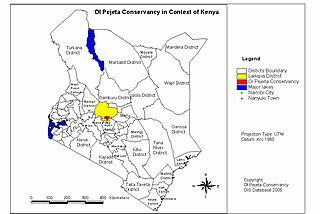
The Ol Pejeta Conservancy is a 360 km2 (140 sq mi) not-for-profit wildlife conservancy in Central Kenya's Laikipia County. It is situated on the equator west of Nanyuki, between the foothills of the Aberdares and Mount Kenya. The Ol Pejeta Conservancy works to conserve wildlife, provide a sanctuary for great apes, and generate income through wildlife tourism and complementary enterprises for re-investment in conservation and community development.














